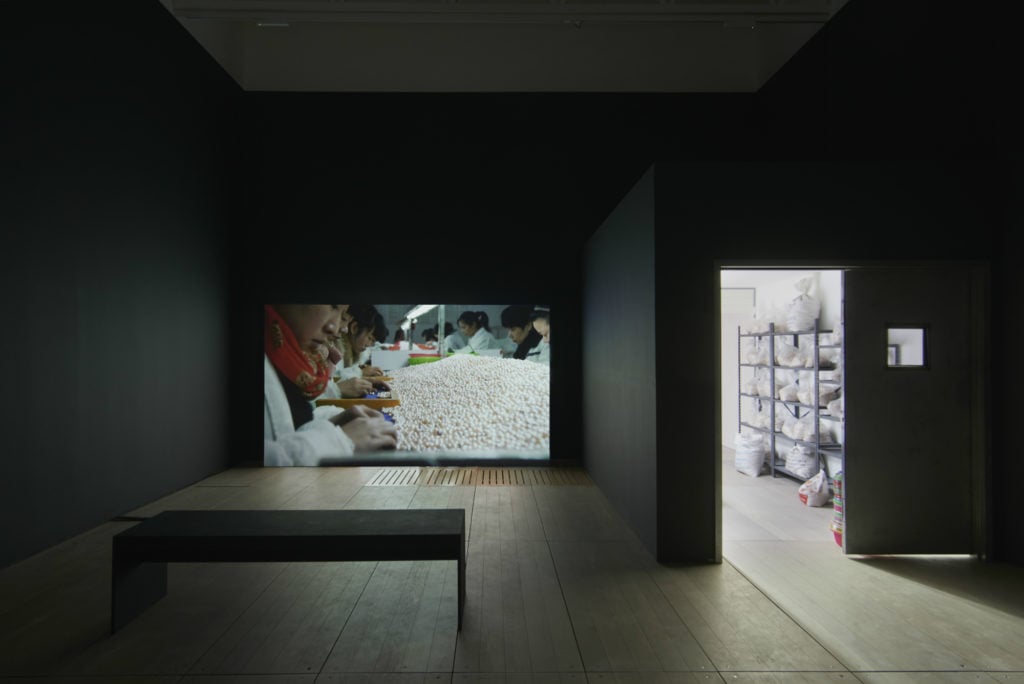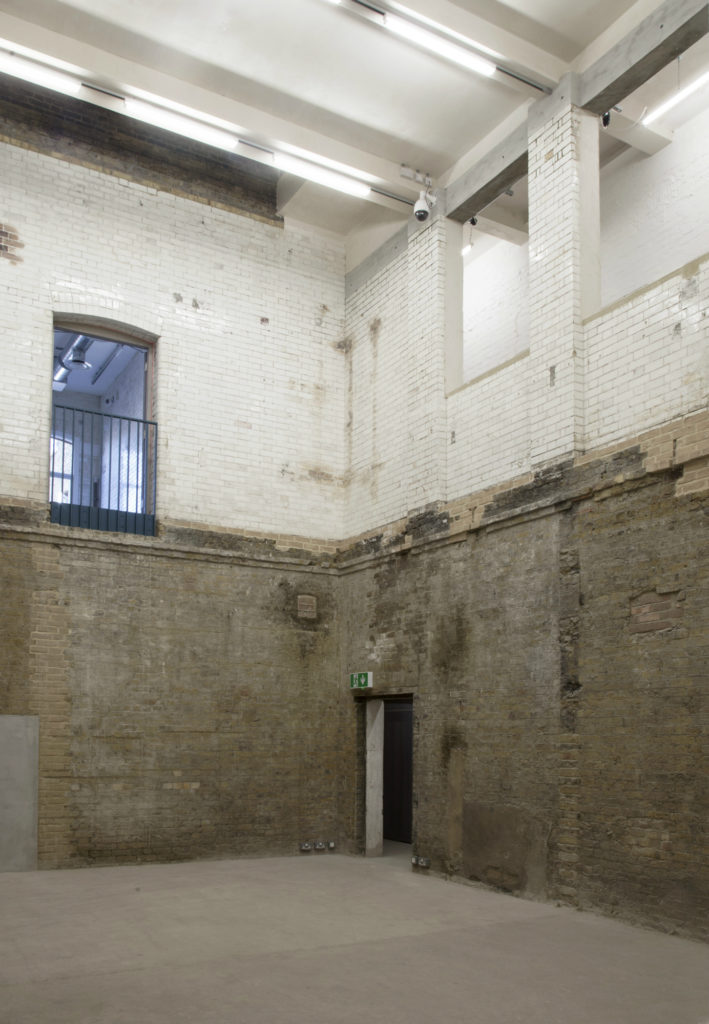Art World
Backed by Damien Hirst and Other Illustrious Alumni, Goldsmiths Opens Its New Contemporary Art Center
The public gallery designed by Turner Prize-winners Assemble launches with a topical exhibition from Mika Rottenberg.

The public gallery designed by Turner Prize-winners Assemble launches with a topical exhibition from Mika Rottenberg.

Javier Pes

A new art gallery funded in part by Goldsmiths’ most famous alumni opened to the public this weekend. Donations came from Damien Hirst, who gave both spot and spin paintings to raise funds for the new $5.4 million Goldsmiths Centre for Contemporary Art, and Antony Gormley, who donated a sculpture.
The donors’ board of Goldsmiths CCA is also stacked with other notable British artists, including Steve McQueen, Bridget Riley, Sarah Lucas, Gillian Wearing, Yinka Shonibare, Glenn Brown, and Michael Landy, among others. Former Goldsmiths’ tutor and YBA godfather, artist Michael Craig-Martin, has been thanked too for his support.
Creating a 10,760-square-foot international art gallery in the heart of Goldsmiths, which is part of the University of London, was never going to be priority for its senior management, says Richard Noble, the head of the art department since 2010. But the naysayers were persuaded when 32 alumni donated their art for a fundraising auction that raised nearly $2 million in 2015. Galleries also came out to back the project, including Sadie Coles, Pilar Corrias, Lisson, and Thomas Dane.
Noble says it helped that most of the space that is now the Goldsmiths CCA was a semi-derelict part of the college’s campus in South London. The ground-floor gallery was a cramped seminar room, says Andrew Renton, a director of Marlborough Contemporary who is professor at Goldsmiths. Originally part of a Victorian-era public baths, the warren of “found” spaces, including two massive, cast-iron water tanks on the roof, have been skillfully converted by the art and architecture collective Assemble into a sequence of seven distinctive and sometimes quirky gallery spaces.

Installation view of Mika Rottenberg’s show at Goldsmiths Centre for Contemporary Art. Photo: Andy Keate, courtesy of the artist and Goldsmiths CCA.
Mika Rottenberg’s inaugural solo show is a terrific fit, although Noble admitted that initially he was skeptical. Speaking at the press preview, he paid tribute to the New York-based artist and center director Sarah McCrory, who chose to organize a “small survey” of Rottenberg’s sinister but humorous works rather than opt for a more obvious group show. Alumnis work may appear but do not expect to see them en masse. The first will be Oisin Byrne, a 2017 MFA graduate, McCrory revealed.
McCrory, a former director of Glasgow International who also curated Frieze Projects, arrived in 2016 after Assemble had won the international competition to design Goldsmiths CCA. It marks the collective’s first art gallery design and their pitch was chosen before they won the Turner Prize in 2015. “We were the wild card,” says Paloma Strelitz, who with Adam Willis, is the project’s lead architect. They have outdone themselves, preserving original features such as old pipes, I-beams, and the building’s rough edges, while adding new spaces that are more in line with the white cube.

The Tank Gallery, Goldsmiths CCA. © Assemble.
Memorable spaces include Tank Gallery, which consists of two former water tanks that were originally used for the later 19th century wash house and swimming pool next door. Both resemble the riveted hull of an ocean liner, but one has been transformed into a roof terrace and the other into a black-box space for Rottenberg’s show. Assemble also “dyed” the tanks’ riveted surfaces to a deep indigo using a “home brewed” iron acetate stain. The collective also made metal stacking chairs that have a bespoke iridescent surface. It is inevitable that it will be called the “Goldsmiths chair.”
Inside one of the former water tanks, an installation of Rottenberg’s Frying Pans (2018) features frying pans on portable stoves that sizzle when a drop of water falls from the ceiling. It is a fitting use of the already atmospheric space and a witty reference to its history.
Near the frying pans is the video work Cosmic Generator (2017), last seen at Skulptur Projekte Münster, which refers to global trade routes, migrant labor, and exploitation. In reality at Goldsmith’s CCA, the conditions of the workers employed by a subcontractor to clean the site has been a contentious issue. On preview day, a small but creative group of students and staff demonstrated in solidarity with the cleaners. Rottenberg has also expressed her support for their fight.
Noble said the ongoing dispute with their cleaning staff was “our reality,” adding that “it won’t be the last.” He stressed that money for the new art gallery came mainly from donors and foundations, not from the college. These include philanthropists Dimitris Daskalopoulos, after whom the Tank Gallery is named. The Mortimer and Theresa Sackler Foundation is also listed as a supporter, which may prove controversial in the future.
McCory, who seemed unfazed as the protesters’ wheatpasted a gallery window and blew horns during the press preview, said that the issues raised by the group “Justice for Cleaners” will be debated in the gallery’s project space, officially called the Oak Foundation Gallery, during Rottenberg’s exhibition. This is the largest space in the gallery and will be typically devoted to talks, performances, family activities, and short-run exhibitions. It functions as an atrium, but the triple-height room is far removed from the typically bland spaces found in newly built art galleries around the world. Adam Willis of Assemble compares the unclad walls showing the building’s scars as its “geological strata.”

The lofty Project Space at the heart of Goldsmiths CCA. © Assemble.
McCrory says that Goldsmiths CCA will want to show international artists that any art gallery in London “worth its salt” would want to exhibit. But she sees its peers more in terms of “pedagogical” galleries in educational institutions, such as Portikus in Frankfurt and the CCA Wattis in San Francisco. Therefore, Goldsmiths’ exhibition program will echo its donors board. So instead of names such as Hirst, Gormley or the many other former Goldsmiths’ students who have won or been shortlisted for the Turner Prize, Rottenberg will be followed in the fall by late Scottish poet and humorist Ivor Cutler, the Estonian artist Kris Lemsalu, and the late feminist artist Alexis Hunter. Next spring a group show of work by the Chicago Imagists will be a first for London.
On paper London might not need another public art gallery. But with Assemble’s classy conversion of what were, as they say “robust but ropey” old buildings, and McCrory’s dynamic programming, Goldsmiths CCA looks set to quickly establish itself on the international art map. It already has “brand” recognition thanks to the YBAs, Hirst, and co.
“Mika Rottenberg” is on view through November 4 at Goldsmiths CCA, London.